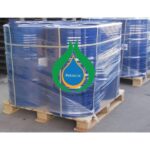CALCIUM CHLORIDE
Prepared at the 19th JECFA (1975), published in NMRS 55B (1976) and in
FNP 52 (1992). Metals and arsenic specifications revised at the 63rd JECFA
(2004). An ADI ‘not limited’ was established at the 17th JECFA (1973)
SYNONYMS INS No. 509
DEFINITION
Chemical names Calcium chloride
C.A.S. number 10043-52-4
Chemical formula Anhydrous: CaCl2
Dihydrate: CaCl2 · 2H2O
Hexahydrate: CaCl2 · 6H2O
Formula weight Anhydrous: 110.99
Dihydrate: 147.02
Hexahydrate: 219.08
Assay Anhydrous: Not less than 93%
Dihydrate: Not less than 99.0% and not more than the equivalent of 107.0% of
CaCl2 · 2H2O
Hexahydrate: Not less than 98.0% and not more than the equivalent of 110%
of CaCl2 · 6H2O
DESCRIPTION Anhydrous: White, deliquescent lumps or porous masses
Dihydrate: White, hard, deliquescent fragments or granules
Hexahydrate: Colourless, very deliquescent crystals
FUNCTIONAL USES Firming agent
CHARACTERISTICS
IDENTIFICATION
Solubility (Vol. 4) Anhydrous: Freely soluble in water and ethanol
Dihydrate: Freely soluble in water; soluble in ethanol
Hexahydrate: Very soluble in water and ethanol
Test for chloride (Vol. 4) Passes test
Test for calcium (Vol. 4) Passes test
PURITY
Free alkali Not more than 0.15% as Ca(OH)2
Dissolve 1 g of the sample in 20 ml of freshly boiled and cooled water, and
add 2 drops of phenolphthalein TS. If the solution is pink, the pink colour is
discharged by adding 2 ml of 0.02 N hydrochloric acid.
Magnesium and alkali
salts
Not more than 5%
Dissolve 1 g of anhydrous calcium chloride, or the corresponding weight of a
hydrate, in about 50 ml of water, add 500 mg of ammonium chloride, mix and
boil for about 1 min. Quickly add 40 ml of oxalic acid TS, and stir vigorously
until precipitation is well established. Immediately add 2 drops of methyl red
TS, then add ammonia TS dropwise until the mixture is just alkaline, and cool.
Transfer the mixture into a 100-ml cylinder, dilute with water to 100 ml, let
stand for 4 h or overnight, and then decant the clear, supernatant liquid
through a dry filter paper. To 50 ml of the clear filtrate in a platinum dish add
0.5 ml of sulfuric acid and evaporate the mixture on a steam bath to a small
volume. Carefully evaporate the remaining liquid to dryness over a free flame,
and continue heating until the ammonium salts have been completely
decomposed and volatilized. Finally, ignite the residue to constant weight. The
weight of the residue does not exceed 25 mg.
Fluoride (Vol. 4) Not more than 40 mg/kg (Method III)
Lead (Vol. 4) Not more than 2 mg/kg
Determine using an atomic absorption technique appropriate to the specified
level. The selection of sample size and method of sample preparation may be
based on the principles of the method described in Volume 4, “Instrumental
Methods.”
METHOD OF
ASSAY
Weigh accurately about 1 g of anhydrous calcium chloride, or the
corresponding weight of a hydrate, transfer to a 250-ml beaker, and dissolve
in a mixture of 100 ml of water and 5 ml of dilute hydrochloric acid TS.
Transfer the solution to a 250-ml volumetric flask, dilute with water to volume
and mix. Pipet 50 ml of the solution into a suitable container, add 100 ml of
water, 15 ml of sodium hydroxide TS, 40 mg of murexide indicator (amm.
purpurate) and 3 ml of naphthol green TS, and titrate with 0.05 M disodium
ethylenediaminetetra-acetate until the solution is deep blue in colour. Each ml
of 0.05 M disodium ethylenediaminetetraacetate is equivalent to 5.55 mg of
CaCl2; 7.35 mg of CaCl2 · 2H2O; or 10.95 mg of CaCl2 · 6H2O.
Petro Chemical Supplying Company is a global Group based in Turkey which manufactures and provides chemical and raw material in different cases with deep industrial experiences.




